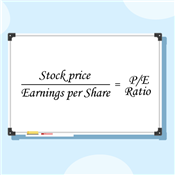The Risks of Buying on Margin
Buying on margin could magnify your profits. But it could also magnify your losses. Before you get tempted, understand how this risky strategy works.
 |
| © CreditDonkey |
The Definition of Buying on Margin
First, let's look at what buying on margin means. You borrow money to invest. But there's no guarantee that the investment will turn out positive.
You take the risk of leveraging your profit or amplifying your losses. In short, you buy more than you can afford. But remember, no matter how the stock performs, you have to pay the $1,500 loan back.
If XYZ stock bites the dust, you may owe more than you have available.
So you borrow $1,500 from your broker, increasing your investment to $3,000. Now, you'll end up in one of two places.
- 1. You may increase your profits based on the larger number of shares you bought.
- 2. You may also lose more than your initial $1,500 investment.
This is just the start of the risk when buying on margin. Keep reading to learn more.
How Buying on Margin Works
Just like any other loan, buying on margin costs you money in interest. Your broker borrows funds at very low interest rates. They then turn around and lend the money to you.
They charge you slightly higher interest rates. This way, they make a profit. Now you feel enticed to buy more stock than you could afford on your own.
In order to borrow the funds, you have to guarantee you'll repay the funds. You do this with collateral. The Federal Reserve Board requires that you put up 50% of the investment.
Using the previous example, you have $1,500 in cash. This means you can borrow an additional $1,500 to double your investment. But you have to guarantee a minimum amount of equity based on the stock's value at any given time.
If the stock increases in price, you don't have to worry about your equity position. If the stock price decreases, though, you could end up with less than the required maintenance margin.
If this happens, the broker can execute a margin call. This is a dreaded word in the world of margin buying. The broker then requires you to fund your account with additional cash to reach the required equity position.
If you don't have the cash, you'll have to liquidate stock in order to reach the desired point.
Buying stock on margin has its advantages. But it's important to focus on the disadvantages. This way you know the worst-case scenario that you may be setting up for yourself. Read on to learn more.
The Risks
Know the risks associated with buying stock on margins BEFORE you begin:
The Stock Falls Drastically
No one can predict what stocks will do in the future. If they fall, you still have to pay back the money you borrowed.
Brokers don't care that your stock plummeted even though you predicted otherwise. You have to make good on your word. You do this by funding your account with the difference in equity that you lost.
If you don't pay, you'll likely find yourself in court. The broker will try to obtain judgments to seize any other assets you own. Your only hope is to file for bankruptcy.
It's Easy to Get Approved
Another large risk of buying on margin is how easy it is to be approved. Some brokers even give margin capability with every brokerage account opened.
Read the forms you sign carefully when you sign up for a brokerage account. You don't have to buy on margin just because you have the capability to do so.
The Margin Call
The dreaded margin call can really hurt your investment. The Federal Reserve Board requires a 25% equity position at all times. But you'll be hard-pressed to find a broker that allows such a small amount.
You'll typically find requirements between 30-40% instead. You have 24 hours to fund the difference when the stock's value drops. This could easily put you in financial turmoil in the blink of an eye.
The Stock Price Doesn't Change
Buying stock on margin costs you money even if the stock price doesn't change. You owe interest for every day you borrow the funds.
Let's say you borrow money to buy a stock that you hold for 6 months. Then you'll owe interest on that money for the entire 6 months. If the stock price never changed, you lose out on the investment despite the stock not changing.
Comparing Buying on Margin with Buying with Cash - Example #1
This is not to say that buying on margin always goes wrong. There can be a good side. But there's no way to predict what will happen.
You can't simply wait a stock out and hope that it comes back up. You borrowed the funds, so you'll have to pay them back one way or the other.
Let's compare buying on margin and with cash using an example:
On Margin
XYZ stock trades for $50/share today. You have $2,500 in cash, which could buy 50 shares. But you feel bullish, so you want to buy 100 shares.
You borrow $2,500 to buy the stocks on margin. Right now, you have 50% equity in the stock.
If XYZ stock increases to $60/share, your investment appreciates. Your investment is now worth $6,000. You still owe the $2,500 margin loan. This leaves you with $3,500 profit.
That's a 40% return on your $2,500 investment: $3,500 (profit) - $2,500 (initial cash investment) = $1,000
$1,000/$2,500 = 40% return
With Cash
Now, what if you bought the 100 shares with your own cash? Let's take a look:
You'd need $5,000 in cash. You'd invest the entire amount in 100 shares at $50/share.
If the stock increased to $60/share, your investment would be worth $6,000. You don't owe any loans, so you keep the $6,000, leaving you with a $1,000 profit. This is only a 20% return on your investment though, because you laid out more of your own cash:
$1,000 (profit)/$5,000 (initial investment) = 20% return
Based on this example, you'd double your returns when you buy on margin rather than paying cash.
But as we all know, stocks don't always appreciate. Read on for another scenario.
Comparing Buying on Margin with Buying with Cash - Example #2
We'll use the above example of buying XYZ stock at $50/share.
On Margin
You bought 100 shares on margin. You funded your account with the required $2,500 and borrowed $2,500.
What would happen if XYZ stock fell to $25/share? You'd lose $25/share, or $2,500. Your total investment is worth $2,500 and you owe $2,500. Your equity disappears.
To keep the stock, you'll have to meet the equity requirements. The stock is worth $2,500, so you'd need $625 in your account at a minimum.
If you choose to wait the stock out, you can keep it and continue paying interest on the loan. If you decide to jump ship, you'll break-even on the investment, but you owe interest.
In this case, your loss would equal the amount of interest accrued.
With Cash
What if you paid cash for the stock? You would have invested $5,000 of your own money. At $25/share, the stock is only worth $2,500. You'd take a loss of $2,500, or 50%.
If you bought on margin, you would break-even, not taking into consideration the interest you'd owe.
Here's a breakdown of the maintenance requirements for each drop in the stock price. If the broker has a 25% maintenance requirement, you can see the stock price at which you'd receive a margin call.
| Stock | Current Price | Value | Equity | Equity % | Maintenance Requirement |
|---|---|---|---|---|---|
| XYZ Stock | $50 | $5,000 | $2,500 | 50% | $1,250 |
| XYZ Stock | $45 | $4,500 | $2,000 | 44% | $1,125 |
| XYZ Stock | $40 | $4,000 | $1,500 | 37.5% | $1,000 |
| XYZ Stock | $35 | $3,500 | $1,000 | 28.5% | $875 |
| XYZ Stock | $30 | $3,000 | $500 | 17% | $750 |
| XYZ Stock | $25 | $2,500 | $0 | 0% | $625 |
| XYZ Stock | $20 | $2,000 | -$500 | -25% | $500 |
Selling Stock Bought on Margin
Eventually, you'll sell the stocks you bought on margin. In fact, a good theory is to use this practice for short-term investments only. When you sell, one of two things happens:
- Make 100% of the net profit
- Take 100% of the full loss
In both cases, you only pay a portion of the cost of buying the stock. If the stock goes up, you make increased profits. If the stock goes down, you take a larger loss.
In short, buying on margin increases your profits and your losses. One of your biggest risks, however, is time. You know you have market risk - no one can predict what the market will do.
The Bottom Line
Buying stocks on margin is risky business. While you may inflate your profits, you also inflate your losses. It's only recommended for very short-term investments for which you expect a drastic change.
However, unless you have other securities you can use to pay back the loan, proceed with caution. Think of the worst-case scenario. How would you pay back the loan if the stock dropped to $0?
If you can't pay it back with stock you own or cash in another account, don't do it. Buying on margin can seem promising, but it's a strategy that requires extreme caution.
Write to Kim P at feedback@creditdonkey.com. Follow us on Twitter and Facebook for our latest posts.
Read Next:






